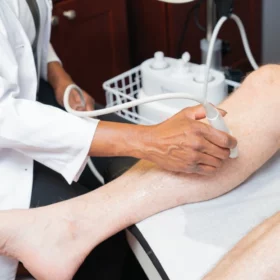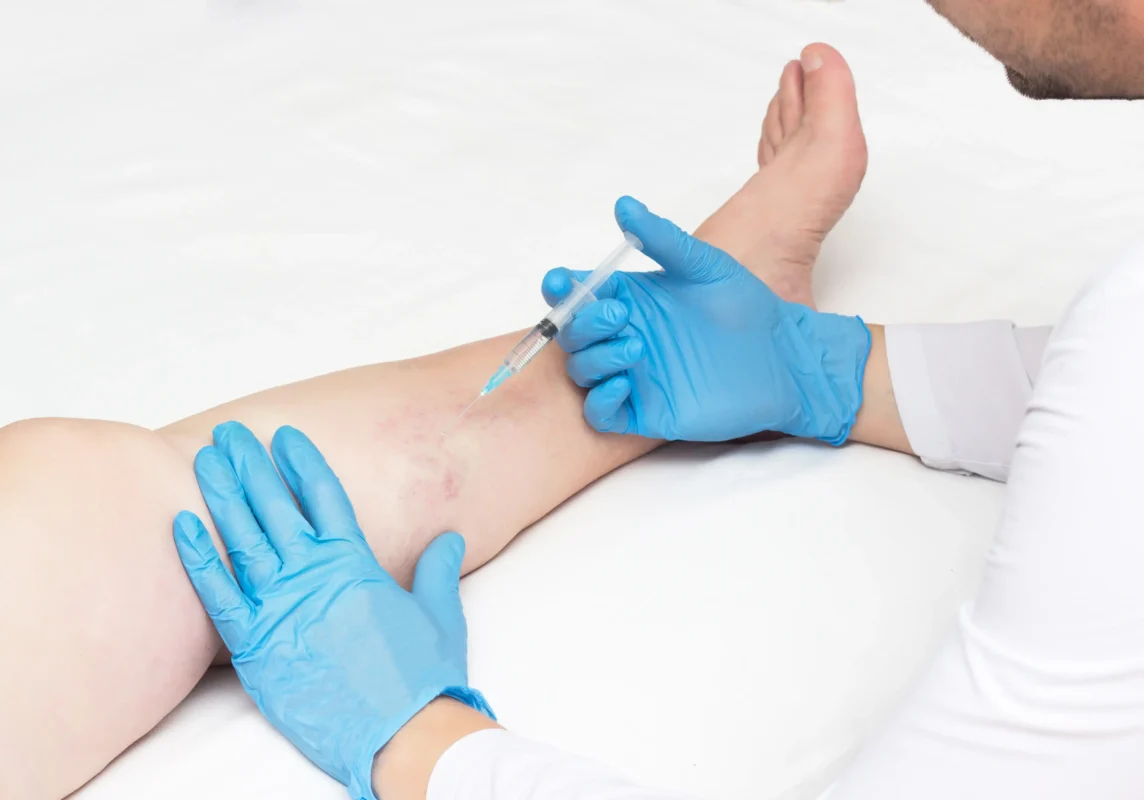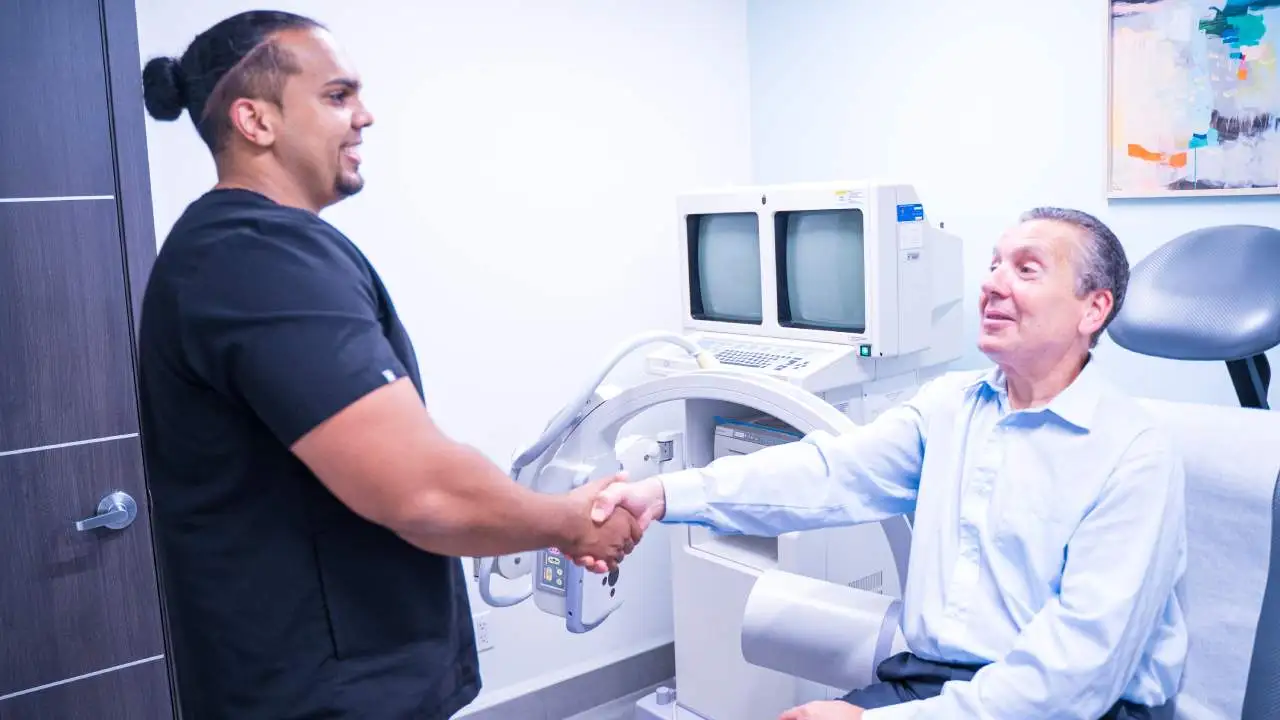If you’re struggling with varicose or spider veins, finding the right treatment can significantly improve your quality of life. Fortunately, advancements in medical technology have made minimally invasive vein treatments accessible and effective. However, with various options available, selecting the most suitable one for your needs can be difficult.
At Vein Treatment Clinic, we only offer the latest and safest minimally invasive vein treatments, such as sclerotherapy, endovenous laser ablation, and microphlebectomy. Our vein doctors carefully examine your leg veins and recommend the most suitable treatment plan. You can find our vein clinics in New York, New Jersey, California, or Maryland. Please schedule an appointment at your nearest vein treatment clinic today. In this guide, we walk you through the process of selecting the right vein treatment for you.
1. Understanding Your Vein Condition
Before diving into treatment options, it’s crucial to understand your vein condition. Varicose veins, characterized by enlarged, twisted veins often seen on the legs, can cause discomfort and affect your confidence. Spider veins are smaller, red or blue veins that appear closer to the skin’s surface. These conditions can be caused by various factors, including genetics, pregnancy, obesity, or prolonged standing or sitting. Consulting with a vein specialist will help you determine the severity of your condition and which treatment options are suitable.
During your consultation, your vein specialist will conduct a thorough examination, which may include visually assessing your veins and performing diagnostic tests such as a Duplex ultrasound. These tests can help identify the underlying causes of your vein issues and determine the most appropriate treatment approach.
2. Severity of Spider Veins and Varicose Veins
The severity of your spider veins or varicose veins will influence the type of treatment recommended. Mild cases, where symptoms are minimal and cosmetic concerns are the primary issue, may be effectively treated with non-invasive treatments like sclerotherapy, lifestyle changes, and wearing compression stockings. Lifestyle changes may include maintaining a healthy weight, avoiding prolonged periods of sitting or standing, and regular exercise to improve circulation.
For more pronounced or symptomatic veins, minimally invasive procedures such as endovenous laser ablation, radiofrequency ablation, or ambulatory phlebectomy may be recommended. Endovenous laser ablation involves inserting a thin laser fiber into the affected vein, which emits laser energy to seal the vein shut, while ambulatory phlebectomy involves making small incisions on the skin’s surface to remove unwanted varicose veins.
3. Chronic Venous Insufficiency (CVI)
Chronic venous insufficiency (CVI) is a condition where the veins have difficulty returning blood from the legs to the heart, leading to symptoms such as swelling, pain, and skin changes. It can be caused by underlying issues such as venous reflux or obstruction. If you have CVI, your vein specialist may recommend specific treatments to address the underlying venous insufficiency in addition to treating visible varicose or spider veins.
Common treatments for CVI include endovenous radiofrequency ablation, which uses heat energy to close off diseased veins, and VenaSeal, a minimally invasive procedure that involves injecting a medical adhesive to seal the diseased saphenous vein shut. Your vein specialist will assess your condition and recommend the most appropriate treatment to alleviate your symptoms and improve your venous circulation.
4. Consultation with a Vein Specialist
Seeking professional advice is essential in selecting the right vein treatment. A vein specialist, also known as a phlebologist, is a medical professional with specialized training in diagnosing and treating vein disorders. During your consultation, the board-certified vein specialist will take a comprehensive medical history, perform a physical examination, and order diagnostic tests to assess the extent of your vein issues.
Based on this evaluation, the vein specialist will discuss your treatment options and recommend the most suitable approach for your individual needs. They can provide valuable insights into the pros and cons of each treatment option and address any concerns you may have, ensuring that you feel confident and informed about your decision.
5. Minimally Invasive Treatment Options
Minimally invasive vein treatments offer several advantages over traditional surgical procedures, including shorter recovery times, minimal discomfort, and lower risk of complications. Here are some common minimally invasive options to consider:
- Endovenous Laser Ablation (EVLA): This procedure involves inserting a thin laser fiber into the affected vein, which emits laser energy to seal the vein shut. EVLA is highly effective in treating larger varicose veins and typically requires minimal downtime.
- Radiofrequency Ablation (RFA): Similar to EVLA, RFA uses heat energy generated by radiofrequency waves to close off diseased veins. It’s a safe and efficient treatment option, often preferred for its effectiveness in closing veins and reducing symptoms.
- Sclerotherapy: Sclerotherapy is a versatile treatment for spider veins and smaller varicose veins. During the procedure, a sclerosing agent is injected into the veins, causing them to collapse and eventually fade from view. Multiple sessions may be required for optimal results.
- Microphlebectomy: In cases where veins are too large for sclerotherapy but not suitable for laser or radiofrequency ablation, microphlebectomy may be recommended. It involves making tiny incisions near the affected veins and removing them using specialized tools. Microphlebectomy is particularly effective for bulging varicose veins.
6. Consideration of Treatment Goals and Preferences
When choosing a vein treatment, consider your specific goals and preferences. Are you primarily concerned about improving the appearance of your legs, alleviating discomfort, or both? Do you prefer a treatment with minimal downtime, or are you willing to undergo a slightly longer recovery for potentially better results? Discussing these factors with your vein specialist will help tailor the treatment plan to your individual needs. Your vein specialist will work with you to develop a personalized treatment plan that aligns with your goals and preferences, ensuring that you are comfortable and satisfied with the outcome.
7. Insurance Coverage and Cost Considerations
Before proceeding with vein treatment, it’s essential to understand your insurance coverage and associated costs. While minimally invasive vein treatments are generally covered by insurance for medical reasons, such as pain or swelling, cosmetic procedures may not be covered. Additionally, consider factors like co-pays, deductibles, and any out-of-pocket expenses.
At Vein Treatment Clinic, we always provide assistance in navigating insurance coverage and exploring financing options if needed. Our insurance team can also help you understand the cost implications of each treatment option and develop a plan that fits within your budget. Please contact our vein clinic to request hassle-free insurance verification for your treatment.
Vein Treatment FAQs
What causes varicose and spider veins?
Varicose veins and spider veins can develop due to a variety of factors, including genetics, pregnancy, hormonal changes, obesity, and prolonged sitting or standing. Weak or damaged valves within the veins can lead to poor blood circulation, causing blood to pool in leg veins.
What are the benefits of minimally invasive vein treatments?
Minimally invasive vein treatments offer several advantages over traditional surgical procedures, including shorter recovery times, minimal scarring, and reduced risk of complications such as infection or nerve damage. These treatments can be performed on an outpatient basis, allowing patients to resume their daily activities relatively quickly.
How long do the results of vein treatments last?
The longevity of vein treatment results can vary depending on factors such as the severity of the vein condition, the chosen treatment method, and individual lifestyle factors. While some patients may experience permanent improvement, others may require periodic maintenance treatments to manage recurring symptoms or new vein developments.
Is vein treatment covered by insurance?
In many cases, vein treatment is covered by insurance when deemed medically necessary to alleviate symptoms such as pain, swelling, or skin changes or when your vein conditions are caused by chronic venous insufficiency. However, coverage policies can vary depending on the insurance provider and specific plan. Please request hassle-free insurance verification from our vein clinic to understand your insurance coverage options.
What is the recovery process like after vein treatment?
Recovery from minimally invasive vein treatments is typically relatively quick and involves minimal discomfort. Patients may be advised to wear compression stockings and avoid strenuous activities for a short period following treatment. Most individuals can resume normal activities immediately, although strenuous exercise should be avoided for a few days.
Are there any risks or side effects associated with vein treatment?
While minimally invasive vein treatments are generally safe, some potential risks and side effects may occur. These can include temporary bruising, swelling, or discomfort at the treatment site. In rare cases, complications such as blood clots or allergic reactions to treatment agents may occur. Please discuss potential risks with your vein specialist before treatment.
Can vein treatment improve symptoms other than cosmetic concerns?
Yes, vein treatment can improve various symptoms associated with venous insufficiency, including pain, swelling, cramping, and skin changes such as discoloration or ulcers. By addressing underlying venous issues, minimally invasive treatments can significantly improve the overall health and function of the affected veins.
How soon can I expect to see the results after vein treatment?
The results from vein treatment can vary depending on the specific treatment method and individual factors. Some patients may notice improvements in symptoms, such as pain or swelling, immediately following treatment, while visible changes in the appearance of the veins may take several weeks to months to fully appear.
Contact Us to Select Your Vein Treatment
Choosing the right vein treatment requires careful consideration of various factors, including your vein condition, treatment options, goals, and financial considerations. By seeking guidance from our board-certified vein doctors and understanding the available minimally invasive vein treatments, you can make an informed decision about your vascular health. Schedule a consultation at your nearest vein treatment clinic to address your vein conditions.











